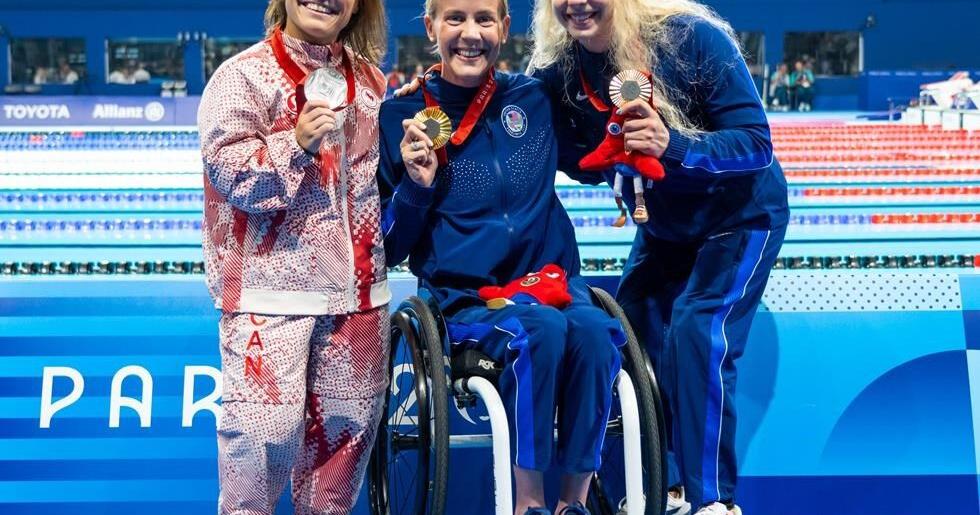PARIS – Canada upgraded its medal colour at the Paralympics on Saturday, but is still searching for its first gold in Paris after Day 3.
Nicholas Bennett of Parksville, B.C., swam to silver in the men’s S14 200-metre freestyle before Tess Routliffe of Caledon, Ont., placed second in the women’s SM7 200-metre individual medley.
The double silver brings Canada’s medal haul to six after the country totalled four bronze medals through two days of full competition.
Routliffe won her second Paralympic medal, earning the same result eight years ago at Rio 2016. The 25-year-old missed the Tokyo Games with a broken back.
Despite returning to the podium, Routliffe wished she could’ve dug a little deeper.
“When we race, all I want is to be able to max out my potential, and I don’t think I fully maxed it out this time,” she said after touching the wall in two minutes 57.17 seconds. “That’s a little disappointing, but it’s how life works.
“I went out there and I raced, and I did the best I could tonight.”
Bennett won his first Paralympic medal. He finished in 1:53.6, but Britain’s William Ellard set a world record in 1:51.30.
“It’s a friendly rivalry between us,” Bennett said. “He’s a good friend and also just an amazing athlete to race against.”
Canada didn’t have the same success in track and field. Wheelchair racing veteran Brent Lakatos placed seventh in the men’s T54 5,000-metre final.
The 44-year-old from Dorval, Que., who owns 11 career medals at the Paralympics, was in second place late in the race before falling off the pace down the stretch.
‘’I’m extremely proud of the whole race,’’ Lakatos said. ‘’I didn’t make any mistakes and executed the plan perfectly. It was just a little bit at the end. Maybe it was the injury, maybe the race, I don’t know.
‘’All I know is that it was just so much fun to be part of that.’’
Elsewhere, Amanda Rummery of Sherwood Park, Alta., was fifth in the women’s T47 400 final and Guillaume Ouellet of Victoriaville, Que., ran to fifth in the men’s T13 5,000 race.
Track cyclist Mel Pemble fell just short of securing her first Paralympic medal with a fourth-place result in the women’s combined C1-3 500-metre time trial. The 24-year-old from Victoria, who competed in alpine skiing at the 2018 Paralympics, finished 0.3 seconds off the podium.
With a qualifying time of 38.512 seconds, Pemble set a C3 category record in the event. The previous world record of 39.093 seconds was set by Australia’s Aniek Van Den Aarssen in 2022.
“It’s pretty cool to come here and realize I’m at my second Games,” Pemble said. “It felt more real coming into these Games with medal potential.
“The world record is going to make that fourth place sting a little less in the end, but I think it’s going to take a little while for me to get over that … it would have been amazing to win a medal, it just wasn’t in the cards this year.”
Jacob Wasserman of Humboldt, Sask., didn’t qualify for the medal race in men’s PR1 single sculls rowing. The Humboldt bus crash survivor, making his Paralympic debut in Paris, was fourth in the repechage heat with a time of 11:28.31.
Arinn Young of St. Albert, Alta., scored 26 points to lead the Canadian women’s wheelchair basketball team to a 63-54 win over Great Britain. Cindy Ouellet of Rivière-du-Loup, Que., added 19 points as Canada improved to 1-1 with group play wrapping up Sunday against Spain.
“We really needed this win today to set us up for the rest of the pool games. I’m so proud of my team. That was a massive team win,” Young said.
“Yeah, I scored the most, but I relied on everyone on court — my whole bench. Everyone was my hype man, and that’s why we got that win today.”
On the men’s side, Great Britain got the best of Canada with an 88-58 victory. Britain’s Philip James Pratt scored 20 points, while Colin Higgins of Rothesay, N.B., led the 1-1 Canadians with 14. Canada next plays Germany on Monday.
In wheelchair rugby, Canada finished group play with a 1-2 record and fell out of medal contention after a 50-46 loss to Japan. Edmonton’s Zak Madell carried the Canadians with 27 tries in the losing effort. Yukinobu Ike’s 15 led Japan.
“It’s pretty miserable — just the way we kind of did it. We showed a lot of fight to come back, but that doesn’t matter if you don’t win. Yeah, it feels awful,” Canada’s Cody Caldwell said.
“We trained for four years to get to the medal round and hopefully win gold, or to compete for gold, and to not even give ourselves a chance, it’s probably one of the worst feelings.”
Canada’s top-ranked women’s sitting volleyball team dropped a four-set decision to Brazil, falling 25-20, 25-21, 23-25, 25-19. The Canadians are now 1-1 in the tournament and take on Rwanda on Monday with hopes of reaching the semifinals.
In wheelchair tennis, Rob Shaw of North Bay, Ont., earned a 6-2, 6-1, win over Ymanitu Silva of Brazil in the first round of the men’s quad singles tournament. He advanced to the quarterfinals.
Montreal boccia player Alison Levine was eliminated by top-ranked Leidy Chica Chica of Colombia in the BC4 quarterfinal. Levine took a 2-0 lead, but ultimately lost 3-2.
This report by The Canadian Press was first published Aug. 31, 2024.

























